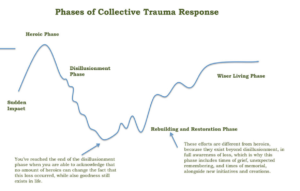So many of my conversations with family, friends and colleagues starts this way. How are we doing? For a few of my friends, they are, honestly, doing really well. For some reason, this moment and its limits are a really good fit for who they are and what they need. They feel strong, resourced, even blessed by the sense of time off and the chance to reflect on what’s most important.
For others, this is a permanent and life-disabling disaster, with no silver lining. Sickness, death, financial insecurity, loss of housing, threats to mental health – it will take years to recover, if recovery is possible at all.
And then many of us talk about a rollercoaster of ups and downs: the sense that sometimes we are falling apart in the face of the threats, and at other times we are oddly and surprisingly resilient and creative.
 Systems (groups of people) go through these kinds of curves as well, and they deeply affect us in ways we don’t always notice. The graph below is something I’ve seen (I can’t find an original source; here is where I found this version of the graph) to describe the systemic response to disaster. It has been incredibly helpful for me. What is shows is that there is a feel-good heroic response toward the beginning that is wonderful, but temporary and a bit illusory. Heroics can’t fix what is going on. The disaster endures and surpasses what heroic action can accomplish.
Systems (groups of people) go through these kinds of curves as well, and they deeply affect us in ways we don’t always notice. The graph below is something I’ve seen (I can’t find an original source; here is where I found this version of the graph) to describe the systemic response to disaster. It has been incredibly helpful for me. What is shows is that there is a feel-good heroic response toward the beginning that is wonderful, but temporary and a bit illusory. Heroics can’t fix what is going on. The disaster endures and surpasses what heroic action can accomplish.
As the community realizes that there is no quick way out of this, disillusionment sets in. There’s no way around the losses and devastation. It must be endured as best as possible. Only after that, and after the worst is over, can a rebuilding and restoration happen.
My observation is that this graph does miss one important aspect of a community’s response. Disbelief, anger, bargaining, and even a violent scarcity mindset that becomes willing to grab what we need even if it is to the detriment of others — and eventually, in that feedback loop that characterizes pandemics, to the likely detriment of even ourselves.
 Many of are experiencing a new and bitter phase of our response, as we see parts of our communities respond this way in the absence of a coherent larger vision from leadership. We have hope when we see evidence of humanity’s “better angels,” (here’s one lovely example, not of individual heroics, but of collective creativity and goodness). However, when we see humanity’s more desperate and destructive behaviors also showing forth in the crisis (taking financial advantage of the situation; attacking front line workers; wearing a KKK “mask” to mock mask-wearing), making it worse than it needs to be, it can lead to real despair. I’ve had my moments of feeling this in the last few weeks. Are we going to be okay? I don’t know.
Many of are experiencing a new and bitter phase of our response, as we see parts of our communities respond this way in the absence of a coherent larger vision from leadership. We have hope when we see evidence of humanity’s “better angels,” (here’s one lovely example, not of individual heroics, but of collective creativity and goodness). However, when we see humanity’s more desperate and destructive behaviors also showing forth in the crisis (taking financial advantage of the situation; attacking front line workers; wearing a KKK “mask” to mock mask-wearing), making it worse than it needs to be, it can lead to real despair. I’ve had my moments of feeling this in the last few weeks. Are we going to be okay? I don’t know.
In constellations, the “First Order of Love” is Acknowledging What Is. Without this, the system cannot move forward. It retains the grief, anger, and fear, so that it churns and continues into the future, becoming something we all, as individuals and as a collective, continue to hold and find a way to manage. We are in an unfolding world-wide disaster. And with our ancestors as our witnesses, who have beheld other disasters, we find a way to bow – not in assent or accord or agreement, but in recognition that this is so, it is bigger than us, this is where we live now. This can give us true strength.
And maybe, if you cannot bow, watch your ancestors bow to their descendants — that’s us — as they see the truth of what is on our plates to face and experience and, perhaps, turn into lasting good.
How are you doing? Really? We are also strengthened when we speak and share our stories. You are welcome to respond on my blog, below.

Leave a Reply